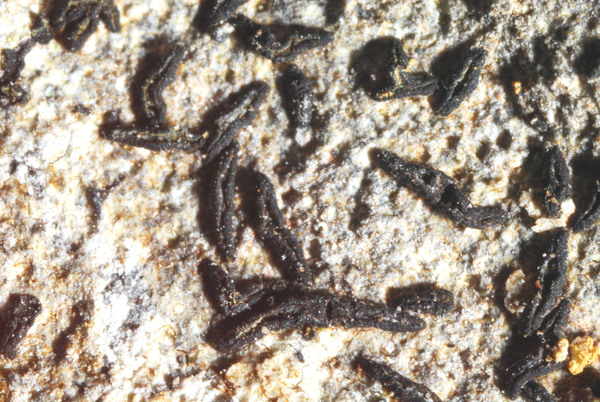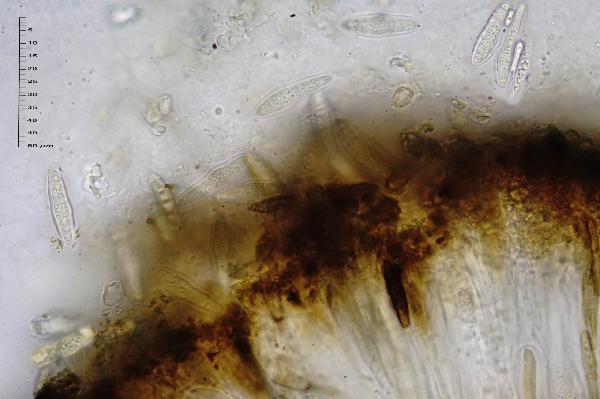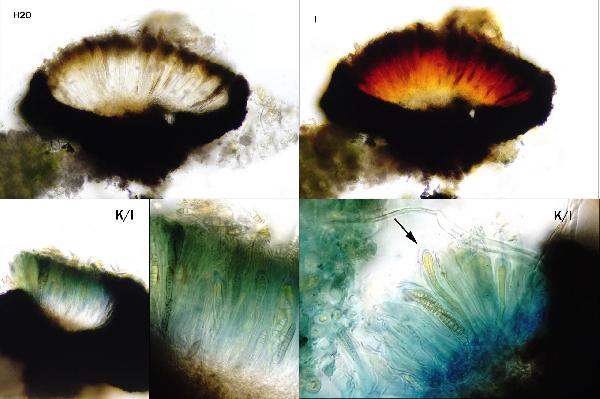Alyxoria mougeotii (A. Massal.) Ertz, Frisch & G. Thor
Taxon, 63: 740, 2014. Basionym: Opegrapha mougeotii A. Massal. - Mem. Lichenogr.: 103, 1853.
Synonyms: Opegrapha leightonii Cromb. ex Nyl.; Opegrapha mougeotii var. pisana Bagl. ex Jatta; Opegrapha mougeotii var. tiburtina Jatta
Distribution: N - VG (TSB 20399), Ven (Lazzarin 2000b), Piem, Lig. C - Tosc, Marc (Jatta 1909-1911), Laz (Genovesi 2003, Genovesi & al, 2012), Sar. S - Camp (Garofalo & al. 1999, Aprile & al. 2003b), Pugl (Nimis & Tretiach 1999), Bas (Herb. Ravera 4374), Cal (Puntillo 1996), Si (Nimis & al. 1994).
Description: Thallus crustose, endosubstratic to thinly episubstratic, smooth to finely cracked, very thin (<0.2 mm), white to cream-coloured. Apothecia lirelliform, black, epruinose, dispersed or grouped, sessile, simple or rarely sparingly branched, to 1.5(-2.5) mm long, 0.2-0.5 mm wide, with pointed ends and a slit-like, rarely finally exposed disc. Proper exciple carbonized, extending below the hymenium, 30-50 µm thick laterally, K-; epithecium brown, 1.2-1.5 μm high, K-; hymenium colourless, 45-70(-120) µm high, I+ red; hypothecium black, carbonized, 20-40(-70) μm high. Asci 8-spored, cylindrical-clavate, the inner layer of endoascus amyloid in upper part, with a I+ blue ring visible around a small ocular chamber, Varia-type. Ascospores 5-7(-8)-septate, hyaline, finally sometimes brownish, spindle-shaped, straight or slightly curved, (19-)25-35(-55) x (4-)6-8(-10) µm, the central cell larger than the others, with a 0.8-2 µm thick perispore. Pycnidia rather frequent, black. Conidia of two types: a) bacilliform, 5-10 x 0.5-1 µm, b) ellipsoid, 3-5 x c. 1.5 µm. Photobiont trentepohlioid. Spot tests: thallus K-, C-, KC-, P-, UV-. Chemistry: without lichen substances.Note: a critical taxon found on steeply inclined surfaces of calcareous or base-rich siliceous substrata (limestone, calcareous sandstone, roofing tiles), in areas with mild winters below the montane belt; related to A. varia.
Growth form: Crustose
Substrata: rocks
Photobiont: Trentepohlia
Reproductive strategy: mainly sexual
Most common in areas with a humid-warm climate (e.g. most of Tyrrenian Italy)
Poorly known taxon in need of further study
Commonnes-rarity: (info)
Alpine belt: absent
Subalpine belt: absent
Oromediterranean belt: absent
Montane belt: absent
Submediterranean belt: very rare
Padanian area: extremely rare
Humid submediterranean belt: rare
Humid mediterranean belt: very rare
Dry mediterranean belt: extremely rare

Predictive model
Herbarium samples


P.L. Nimis; Owner: Department of Life Sciences, University of Trieste
Herbarium: TSB (26274)
2003/03/12
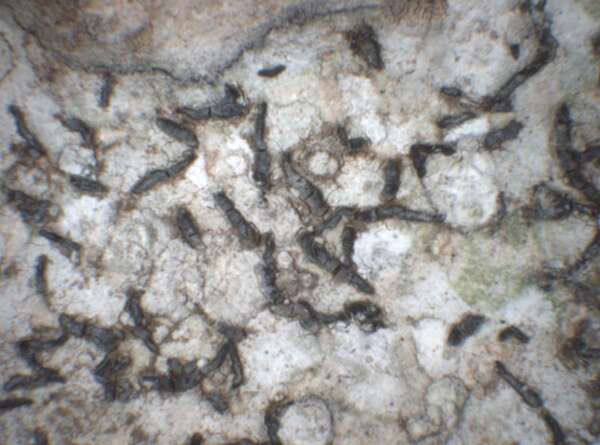

P.L. Nimis; Owner: Department of Life Sciences, University of Trieste
Herbarium: TSB (26274)
2003/03/12
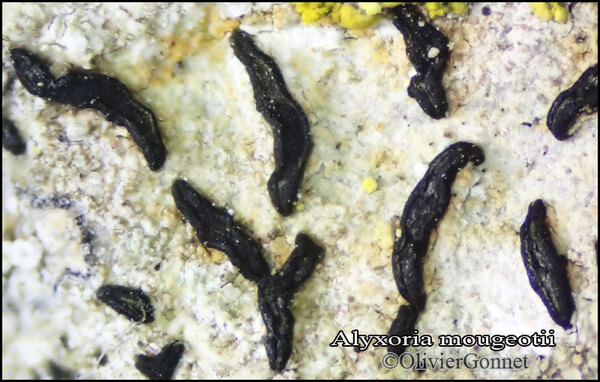
courtesy Olivier Gonnet - Source: https://www.afl-lichenologie.fr/Photos_AFL/Photos_AFL_A/Textes_A2/Alyxoria_mougeotii.htm
France, Olivier Gonnet - session AFL 2015 dans le Lot, Blanzaguet
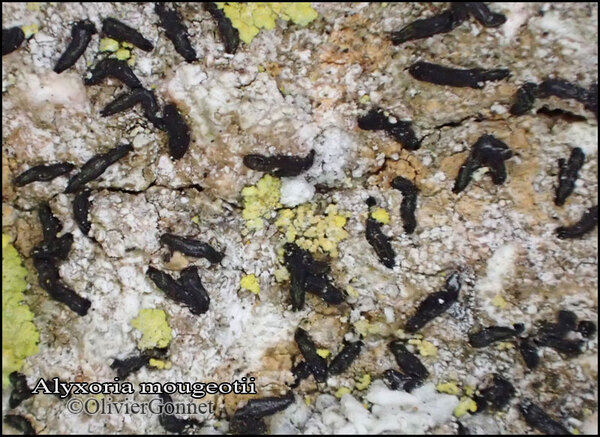
courtesy Olivier Gonnet - Source: https://www.afl-lichenologie.fr/Photos_AFL/Photos_AFL_A/Textes_A2/Alyxoria_mougeotii.htm
France, Olivier Gonnet - session AFL 2015 dans le Lot, Blanzaguet
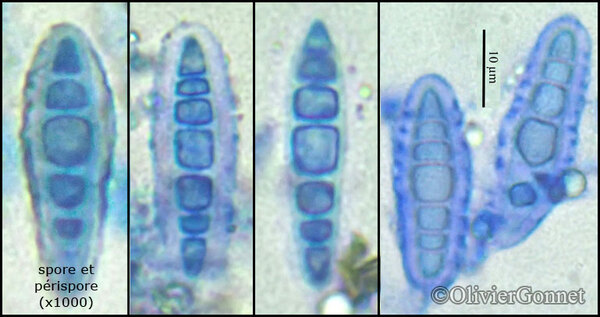
courtesy Olivier Gonnet - Source: https://www.afl-lichenologie.fr/Photos_AFL/Photos_AFL_A/Textes_A2/Alyxoria_mougeotii.htm
France, Olivier Gonnet - session AFL 2015 dans le Lot, Blanzaguet

courtesy Olivier Gonnet - Source: https://www.afl-lichenologie.fr/Photos_AFL/Photos_AFL_A/Textes_A2/Alyxoria_mougeotii.htm
France, Olivier Gonnet - session AFL 2015 dans le Lot, Blanzaguet
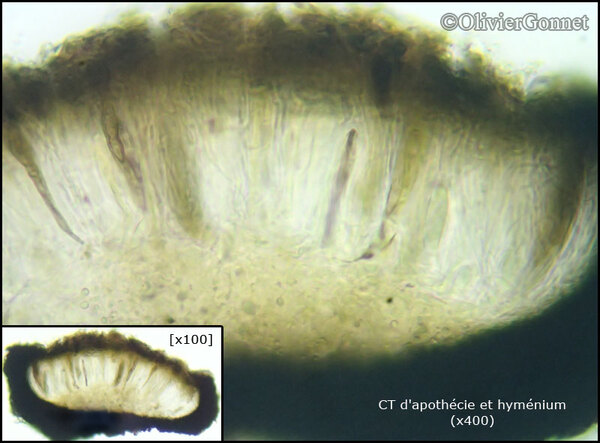
courtesy Olivier Gonnet - Source: https://www.afl-lichenologie.fr/Photos_AFL/Photos_AFL_A/Textes_A2/Alyxoria_mougeotii.htm
France, Olivier Gonnet - session AFL 2015 dans le Lot, Blanzaguet
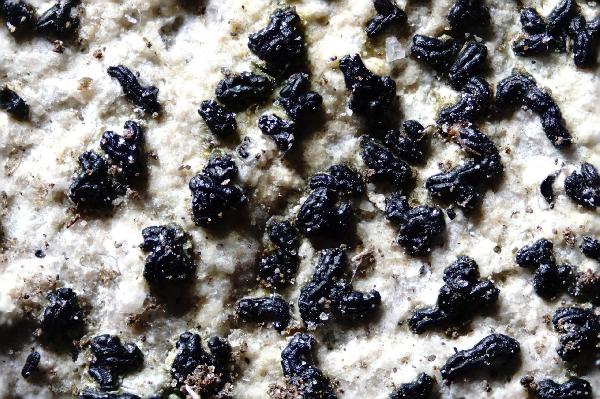
Marta Gonzalez Garcia - Centro de Estudios Micologicos Asturianos
Spain, Jardín Botánico Atlántico (Gijón-Asturias), 21-IX-2022, en rocas calizas, leg. & det. Marta González, ERD-9528.
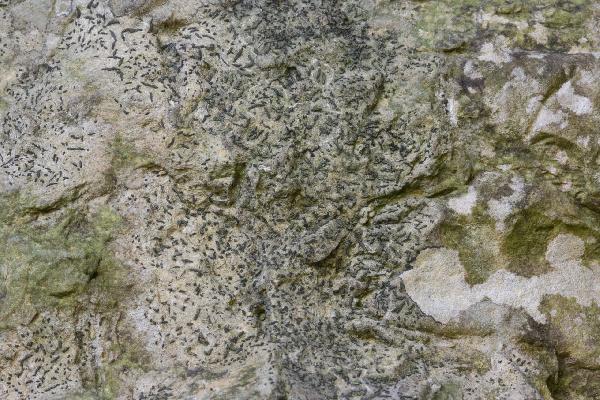
Marta Gonzalez Garcia - Centro de Estudios Micologicos Asturianos
Spain, Jardín Botánico Atlántico (Gijón-Asturias), 21-IX-2022, en rocas calizas, leg. & det. Marta González, ERD-9528.
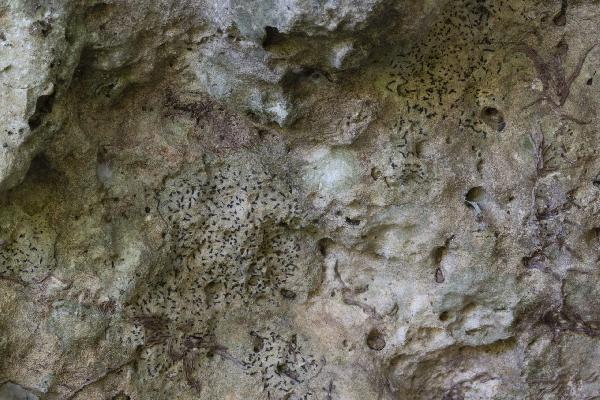
Marta Gonzalez Garcia - Centro de Estudios Micologicos Asturianos
Spain, Jardín Botánico Atlántico (Gijón-Asturias), 21-IX-2022, en rocas calizas, leg. & det. Marta González, ERD-9528.
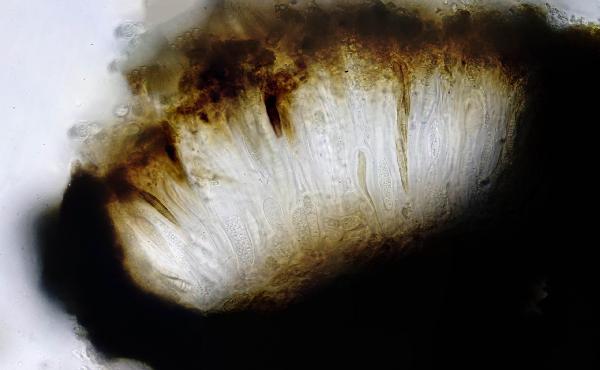
Marta Gonzalez Garcia - Centro de Estudios Micologicos Asturianos
Spain, Jardín Botánico Atlántico (Gijón-Asturias), 21-IX-2022, en rocas calizas, leg. & det. Marta González, ERD-9528.
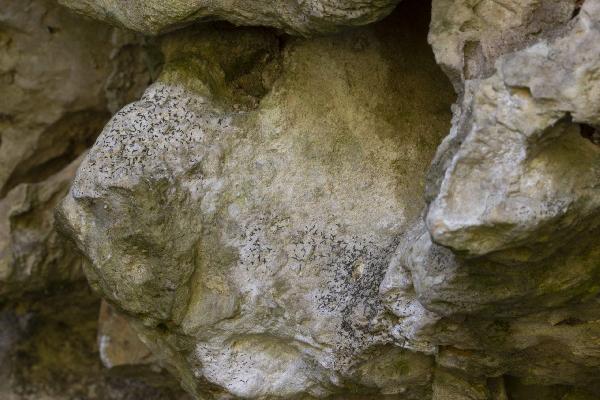
Marta Gonzalez Garcia - Centro de Estudios Micologicos Asturianos
Spain, Jardín Botánico Atlántico (Gijón-Asturias), 21-IX-2022, en rocas calizas, leg. & det. Marta González, ERD-9528.
Growth form: Crustose
Substrata: rocks
Photobiont: Trentepohlia
Reproductive strategy: mainly sexual
Most common in areas with a humid-warm climate (e.g. most of Tyrrenian Italy)
Poorly known taxon in need of further study
Commonnes-rarity: (info)
Alpine belt: absent
Subalpine belt: absent
Oromediterranean belt: absent
Montane belt: absent
Submediterranean belt: very rare
Padanian area: extremely rare
Humid submediterranean belt: rare
Humid mediterranean belt: very rare
Dry mediterranean belt: extremely rare

Predictive model
| Herbarium samples |


P.L. Nimis; Owner: Department of Life Sciences, University of Trieste
Herbarium: TSB (26274)
2003/03/12


P.L. Nimis; Owner: Department of Life Sciences, University of Trieste
Herbarium: TSB (26274)
2003/03/12

courtesy Olivier Gonnet - Source: https://www.afl-lichenologie.fr/Photos_AFL/Photos_AFL_A/Textes_A2/Alyxoria_mougeotii.htm
France, Olivier Gonnet - session AFL 2015 dans le Lot, Blanzaguet

courtesy Olivier Gonnet - Source: https://www.afl-lichenologie.fr/Photos_AFL/Photos_AFL_A/Textes_A2/Alyxoria_mougeotii.htm
France, Olivier Gonnet - session AFL 2015 dans le Lot, Blanzaguet

courtesy Olivier Gonnet - Source: https://www.afl-lichenologie.fr/Photos_AFL/Photos_AFL_A/Textes_A2/Alyxoria_mougeotii.htm
France, Olivier Gonnet - session AFL 2015 dans le Lot, Blanzaguet

courtesy Olivier Gonnet - Source: https://www.afl-lichenologie.fr/Photos_AFL/Photos_AFL_A/Textes_A2/Alyxoria_mougeotii.htm
France, Olivier Gonnet - session AFL 2015 dans le Lot, Blanzaguet

courtesy Olivier Gonnet - Source: https://www.afl-lichenologie.fr/Photos_AFL/Photos_AFL_A/Textes_A2/Alyxoria_mougeotii.htm
France, Olivier Gonnet - session AFL 2015 dans le Lot, Blanzaguet

Marta Gonzalez Garcia - Centro de Estudios Micologicos Asturianos
Spain, Jardín Botánico Atlántico (Gijón-Asturias), 21-IX-2022, en rocas calizas, leg. & det. Marta González, ERD-9528.

Marta Gonzalez Garcia - Centro de Estudios Micologicos Asturianos
Spain, Jardín Botánico Atlántico (Gijón-Asturias), 21-IX-2022, en rocas calizas, leg. & det. Marta González, ERD-9528.

Marta Gonzalez Garcia - Centro de Estudios Micologicos Asturianos
Spain, Jardín Botánico Atlántico (Gijón-Asturias), 21-IX-2022, en rocas calizas, leg. & det. Marta González, ERD-9528.

Marta Gonzalez Garcia - Centro de Estudios Micologicos Asturianos
Spain, Jardín Botánico Atlántico (Gijón-Asturias), 21-IX-2022, en rocas calizas, leg. & det. Marta González, ERD-9528.

 Index Fungorum
Index Fungorum
 GBIF
GBIF
